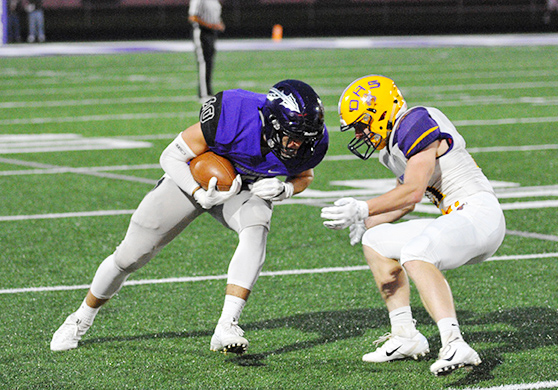Pass Blocking System: Easy and Efficient
One of the oldest-and best-of our football clichés is the put-down of the forward pass: “Whenever you throw a football, three things can happen and two are bad.”
The two bad things are an incompletion and an interception. The good thing, of course, is the completion that involves many more aspects of the game: The quarterback must make the right read, the receiver must run the right pattern and catch the ball, and the QB must be protected.
But for all this to happen, the coach must devise a blocking system that is sound, efficient, easy to teach and allows us to present a system that will help you achieve those goals. The basic rules:1. Commit five down linemen and one other player (back or tight end) to block the defenders.
2. Denote an outside and offside in your play-calling.
3. Provide your QB with an audible system
4. Communication is essential.
5. Have your linemen get as deep into the box as possible. Since depth is essential, the linemen have to achieve it by setting up with their down hand on line with the center’s hips.
The farther the linemen get from the defenders, the easier it becomes to read them and pick up their stunts and movement.
6. When in doubt, block someone, anyone, just protect the QB.
Diag. 1, the System
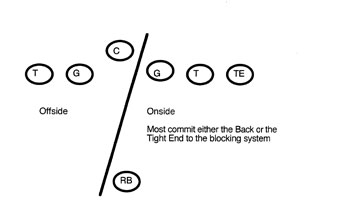
The offensive system dictates the formation, but it must have three blockers on the onside and three blockers on the Offside for the system to be effective.
The philosophy is simple. The blockers must lock onto a defender and keep him occupied until the ball leaves the QB’s hand. The system will dictate the defenders to engage and the alternate options for special situations.
Assignments (by the numbers, counting the defenders).
Onside Blockers:
1. Guard blocks the First defender Onside on or off the LOS.
2. Tackle blocks the Second defender Onside on or off the LOS.
3. Tight End or Running Back blocks the Third defender Onside on or off the LOS.
Offside Blockers
1. Center blocks the First defender Offside on or off the LOS.
2. Guard blocks the Second defender Offside on or off the LOS.
3. Tackle blocks the Third defender Offside on or off the LOS.
Counting the defenders allows the system to be simple but still capable of blocking any defense. The counting of the defenders has to be practiced daily so to minimize the thought process in reacting to a defensive front.
There will always be special situations that have to be understood and practiced daily for the blockers to be comfortable and successful in protecting the QB.
Special Situations:
One of the six basic rules of the Pass Blocking System is communication. There will be situations in which special “calls” will have to be made on the LOS to be successful.
“Squeeze” Call:
The most dangerous situation for a QB (and offensive blockers) is when the “A” gap on the onside is threatened.
The onside guard must now call “squeeze” while the QB, anticipating a quick rush, reads the outside defender. The “squeeze” call can also tell the onside blockers to block to the inside to cover the defenders. The offside blockers must follow their normal blocking assignments.
If both “A” gaps are covered, a “double squeeze” could be called, but an audible in that situation would be a better call. (The audible will be discussed later.)
Diag. 2, “Help-Switch Call”:
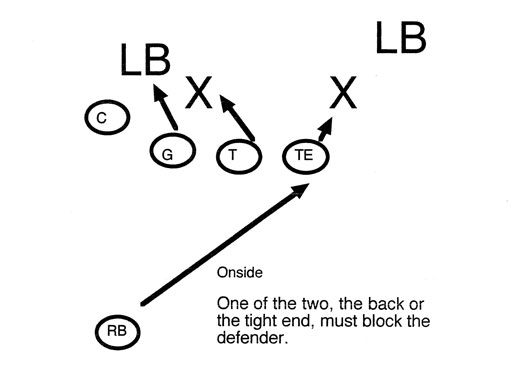
A blocker must make the “help” call whenever the defender is set in a position that impairs his ability to block the defender. A “help” call also permits a “switch” call between two blockers.
The “help” and “switch” must be practiced daily to prevent bad communication or bad execution from leading to a QB sack.
The blockers are given the freedom to make these calls to assure the best possible protection of the QB. The blockers become an indigenous part of the system. The coach should teach and keep teaching the blocking to assure its success.
Diag. 3 “Red-Max” Call:
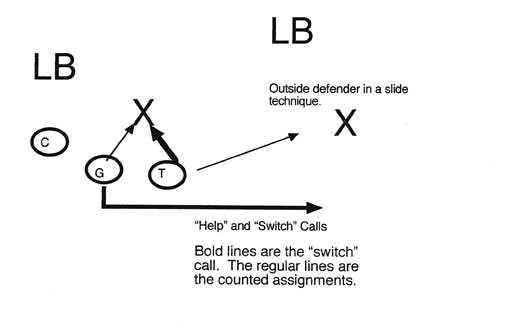
Any offensive player can make a “red” call-alerting the QB to the potential overload or blitz. When the QB hears or sees the “red” call, he must call for Maximum Protection, a “max,” or an audible.
The “max” brings another predetermined blocker into the formation to help block the extra defender.
The other option is an audible that the QB believes will work. Too many defenders in the box will set a receiver free somewhere in the formation.
The offense must have a blitz package for the QB audible. When the audible is called, every blocker must engage his defender to protect the QB.
Communication can also make the system fun. The offensive linemen can play “call” games with the defense. The calls may be coded or just given funny names. If the defense starts listening to the calls, it will be drawn away from its assignments. Make sure that the offensive personnel understand the calls and that everyone is using the same code system.
Blocking Zones:
The system also works well vs stunting defenses. The blockers have to be patient and area-block instead of man-block. This is where the “depth-in-the-box” becomes important.
Wait, watch, and block the defender as he enters the area.
The numbering system remains the same, but instead of assigning a number to a defender it assigns it to an area.
A good scouting report will inform the blockers in the defensive stunts on how best to protect. Practice and more practice will lead to success.
Diag. 4, How the System Works:
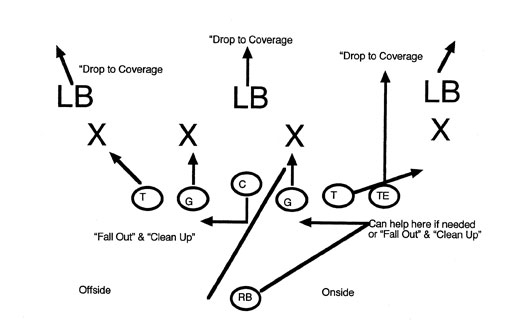
The procedures are simple: the blocker must engage the defender and maintain blocking position until the QB releases the football. If the defender doesn’t rush, the blocker must “fall out” and “clean up.”
The “fall out” is when the blocker blocks down the LOS from the onside to the offside, helping to “clean up” the pass rush.
The “fall out” is very important because it provides help in blocking a strong defender or a defender who has delayed his rush. This is the “clean up.”
In the “fall out” and “clean up,” the blockers must read the defenders. If their assigned players rush, they need to block. If their defender drops, the blocker must “fall out” and “clean up”
The Pass Blocking System is just that-a system. It doesn’t consider individual blocking techniques, quick drop (aggressive), drop back, roll out, the quality of the athletes, or what patterns or pass plays to run. But it will give the offense a blocking system. The system works: just look at the defense and count.
There are other aspects that have to be taken into consideration for the system to work.
Many technical skills that the blockers have to learn and practice in order to protect the QB.
The Pass Blocking System is more the tactical part of the game. The best teaching (learning) tactic to use is the “games approach,” where situations are presented and athletes must respond correctly.
The coach can help the decision process, but the ultimate responsibility rests with the athlete making the right decision and blocking. The more times the athletes see situations, the easier it will become to find the way to do their jobs.
Coach, teach, practice, and more practice. It will make you a winner.

